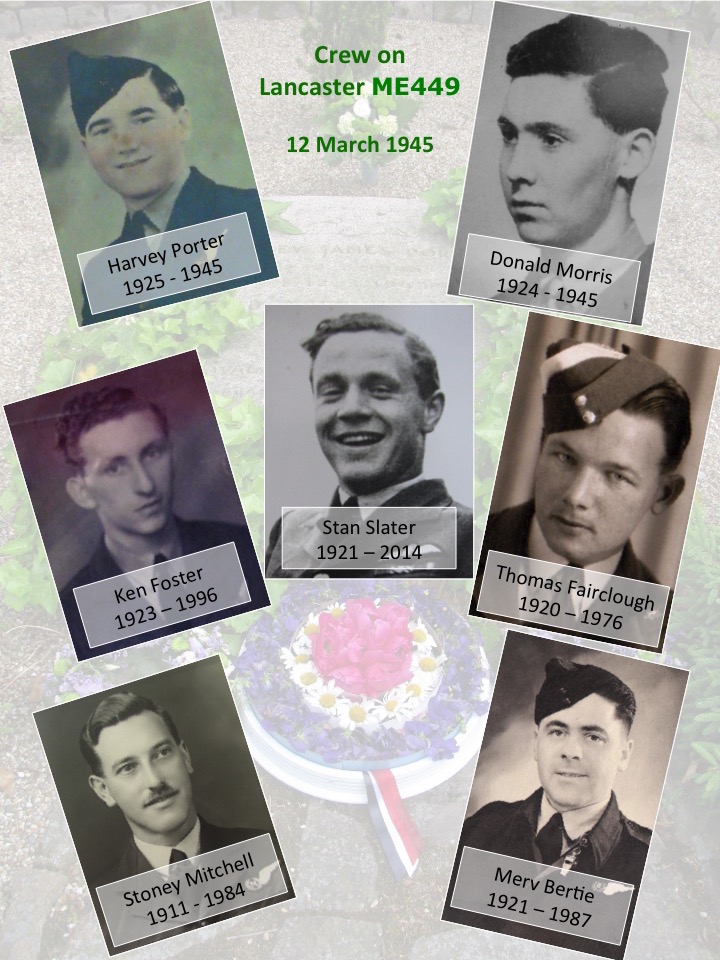12 March 1945
As a consequence of Allied successes in the Western European Area (WEA), by March 1945 German troops and equipment located in Norway were needed to bolster military strength in Germany. Men and materiel were returned to Germany on transport ships sailing from Norway either directly to Baltic ports or via Danish ports in Jutland and then via train into Germany. To thwart or at least delay such movements, Bomber Command mined waters through which German ships were expected to be passing in the near future.
In RAF terminology, gardening refers to the aerial dropping of magnetic or acoustic mines into waters to disrupt German shipping. In keeping with the gardening terminology, coastal areas designated for mine laying were given botanical code names such as asparagus, daffodil, hawthorn, and pumpkin, and the mines were referred to as vegetables (often abbreviated to veg).
On 12 March 1945, in addition to the “thousand bomber” daylight raid on Dortmund, Bomber Command ordered 19 aircraft to plant vegetables in hawthorn, i.e., to lay mines off Kullen Peninsula where the Kattegat between Denmark and Sweden narrows to the northern entrance of the Øresund, located north of Danish Helsingor and Swedish Helsingborg. Five of those 19 aircraft were from 103 Squadron stationed at Elsham Wolds, Lincolnshire.
103 Squadron Operational Record Book (TNA Air 27/817) for Monday 12 March 1945 reports:
Gardening – Kullen Sound
Five aircraft were detailed for the operation and the route followed was:
Base – Scarborough – 5655/0821 – 5630/1051 – TARGET – 0566/1038 – 5550/0700 – Scarborough – Base
All took off safely in fair weather. F/L. Holland returned early due to H.2.S. failure.
On arrival in the garden area it was found to be quite clear and our aircraft successfully laid their vegetables by H.2.S.
Quite a few enemy fighters were seen in the gardening area and some aircraft were seen to go down.
S/L. Slater is missing from this operation. The remaining aircraft landed safely.
The load carried was: (a) 6 x 1500 Veg. (b) 6 x 1950 Veg
| Aircraft | Identity | Pilot | Time Up | Time Veg. Laid | Time Down | Fate of missing aircrew |
| M.E. 449 | PM-T | S/L. Slater | 17:43 | not reported | missing | 2 died, 5 evaded to Sweden |
| L.M. 295 | PM-Z | F/L. Murton | 17:44 | 20:59½ | 23:54 | |
| N.G. 360 | PM-F | F/L. Short | 17:45 | 20:57 | 23:55 | |
| M.E. 475 | PM-L | F/L. Holland | 17:46 | returned early | 22:48 | |
| N.G. 492 | PM-D | F/L. Stepharnoff | 17:47 | 20:55 | 23:44 |
After an outbound flight to the Kattegat lasting a little over 3 hours, mines were laid from a height of 12,000 ft. Three of the four Lancasters from 103 Squadron that made it to target were back on the ground at Elsham Wolds shortly before midnight, but ME449 was shot down at 2145 hours near the western coast of Jutland by Junkers Ju88 D5 + AL flown by Hauptmann Eduard Schröder of 3./NJG3, a staffel within Gruppe 1./NJG3.
Before hitting ME449, Schröder had already shot down two other aircraft returning from the gardening operation in Kullen Sound on 12 March 1945.
At 2116 hours, cannon fire from Schröder’s nightfighter sent Lancaster RA526 coded as P4-J from 153 Squadron into the sea on the west side of the island of Samsø with the loss of six lives; the bomb aimer survived.
A few minutes later, at 2127 hours, Schröder’s hit on NG233 coded BM-E from 433 Squadron sent that Lancaster into the sea between Jutland and Samsø with the loss of all seven lives.
Schröder then headed west over Jutland and at 2145 hours attacked ME449 coded PM-T from 103 Squadron, bringing the Lancaster down over land with loss of two lives.
The three Lancasters shot down by Eduard Schröder on 12 March 1945 were credited as his 24th, 25th, and 26th combat claims for the war.
A detailed map of Schröder’s flight path on 12 March 1945 appears in the article “3 Lancaster fly på 29 minutter” by J. Helme in Flyvehistoriske Tidsskrift 1984 nr. 2
Note: In the 1998 edition of “Royal Air Force Bomber Command Losses of the Second World War 1945”, W.R. Chorley incorrectly ascribes the three Lancasters shot down over Denmark while minelaying on 12 March 1945 to Schröder’s superior Major Werner Husemann, Gruppecommandeur of 1./NJG 3, who was not the pilot of Ju88 D5 + AL. This mis-identification of the nightfighter pilot was perpetuated in the 2016 publication of “RAF Bomber Command Profiles 103 Squadron” by Chris Ward on p. 201.
Note: In the 2004 edition of “Luftwaffe Night Fighter Combat Claims 1939-1945” by J. Foreman, Johannes Matthews, and Simon Parry, the geographic location of Schröder’s third hit at 2145 hours on 12 March is erroneously reported as 75 km N of Bornholm, a site in the Baltic Sea that is about 400 km east of where ME449 was actually shot down near Lyne in western Jutland. This error is repeated in the 2014 edition of “Luftwaffe Aces Biographies and Victory Claims Volume 4” by Johannes Matthews and John Foreman. Mis-reporting of ME449’s crash location also occurs in “Nachtjagd War Diaries Volume Two April 1944 – May 1945” by Theo E. W. Boiten and Roderick J. Mackenzie who combine correct information (grid NS-7 in Jutland) with the incorrect information (N. Bornholm).
 |
 |
| Crew of ME449 12 March 1945 Collage by Gail Michener 2015 | Eduard Schröder Pilot of Ju88 D5 +AL Image source: C. Petersen 1993 “Tyske Fly i Danmark 1940-45 Bind II Natjagere” p. 87. |
Ironically, although gardening was generally considered less dangerous than bombing, the minelaying operation over the Kattegat on 12 March 1945 was significantly more risky than the bombing operations over Germany that same day. Of 1108 aircraft (748 Lancaster, 292 Halifaxes, 68 Mosquitoes) sent on the daylight raid to Dortmund, one Lancaster with seven crew was lost without trace and another Lancaster lost one man whose parachute failed to open when the crew baled out before deliberately ditching the aircraft off the Lincolnshire coast. No losses occurred among 90 Mosquitoes night-time bombing Berlin and three targets in Saxony-Anhalt. Collectively, over 7500 crew were sent to German targets on 12 March 1945 with a loss of 8 men. In contrast, 15 of the 133 crewmen on 19 bombers (16 Lancasters and 3 Halifaxes) sent gardening in Kullen Sound died. Thus, on 12 March 1945, the loss rates were 0.1% for bombing and 11% for gardening.
For any losses, but especially when the loss rate is high, an inevitable question is: “Was that operation worthwhile?”. The question is unfair in that any operation was simply a tiny piece in a huge, and eventually successful, effort to defeat Adolf Hitler and free all the German-occupied nations of Europe. Gardening the northern entrance to Øresund, as with all sea-mining operations, no doubt had some disrupting impact on Germany’s ability to move troops and equipment by necessitating mine-sweeping and diversion of shipping even if none of the mines detonated.